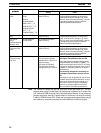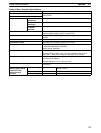
5-1SectionUsing Protocol Macros
63
Item Description
Message con-
tents (contin-
*3:
Error check codes
LRC, LRC2, CRC-CCITT, CRC-16, SUM, SUM1, and SUM2 can be calcu-
lated.
ued)
Maximum length of
send/receive mes-
sages
256 bytes.
Maximum number of
data attributes regis-
tered in one message
96 attributes (see note 1)
Maximum number of
write data attributes
registered in one mes-
sage
30 attributes (see note 2)
Trace function A total of up to 1,700 bytes (characters) of time-series data can be traced in
send and receive messages.
Changes to the step No. and control signals such as RTS and CTS can also
be traced.
Note 1. The CX-Protocol can be used to register up to 96 attributes per message.
2. A macro syntax error will occur when the protocol macro is executed if more
than 31 write attributes are registered in one message.
5-1-3 Using the Protocol Macro Function
The following three methods are available for using the protocol macro function.
When connecting OMRON devices, data is sent and received between the
CQM1H-series CPU Unit and these devices by specifying the sequence number
of the standard system protocol provided in the Serial Communications Board
and CX-Protocol, and executing the sequence using the PROTOCOL MACRO
instruction (PMCR(––)). The CX-Protocol is not required to use the standard
system protocols.
CPU Unit
Serial Communications Board
*Send/receive messages are
stored in the area one or more
words after the send data
address or the receive data
address specified in the
PMCR(––) instruction.
Sequence
number
Sequence No.
specification
Standard system protocol
Sequence No. 001
Step 0
Messages
I/O memory
I/O refreshing
Shared memory
OMRON devices
Step 1
RS-232C or
RS-422A/485
Note The devices for which standard system protocols are provided are listed below.
For details, refer to 5-7 Using Protocol Macros.
Digital Controllers (E5jK, ES100j), Temperature Controllers (E5ZE,
E5jJ), Intelligent Signal Processors (K3Tj), Bar Code Readers
(V500/V520), Laser Micrometers (3Z4L), Visual Inspection Units
(F200/F300/F350), ID Controllers (V600/V620), Hayes Modem AT Com-
mand, and devices supporting the CompoWay/F protocol.
Using the Standard
System Protocols


















